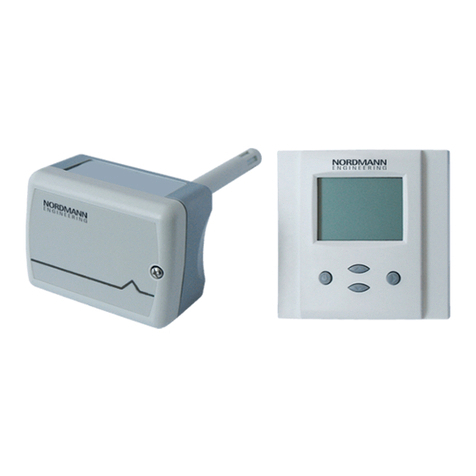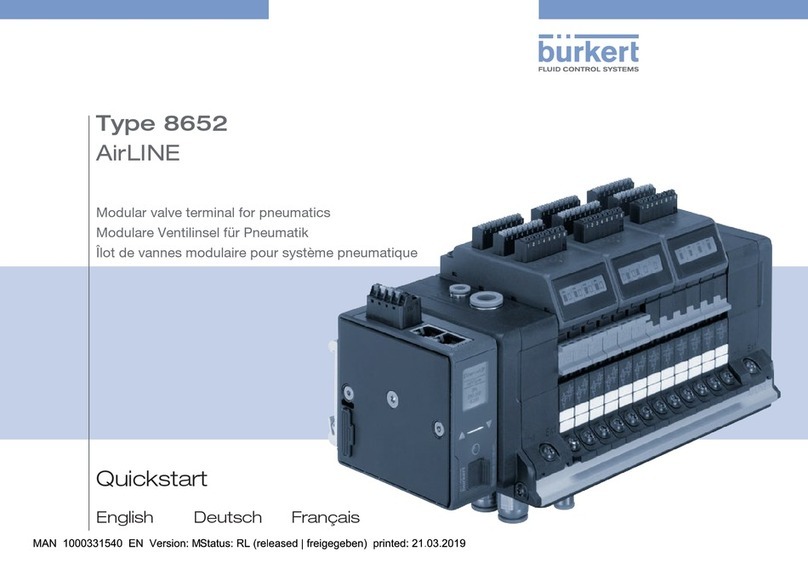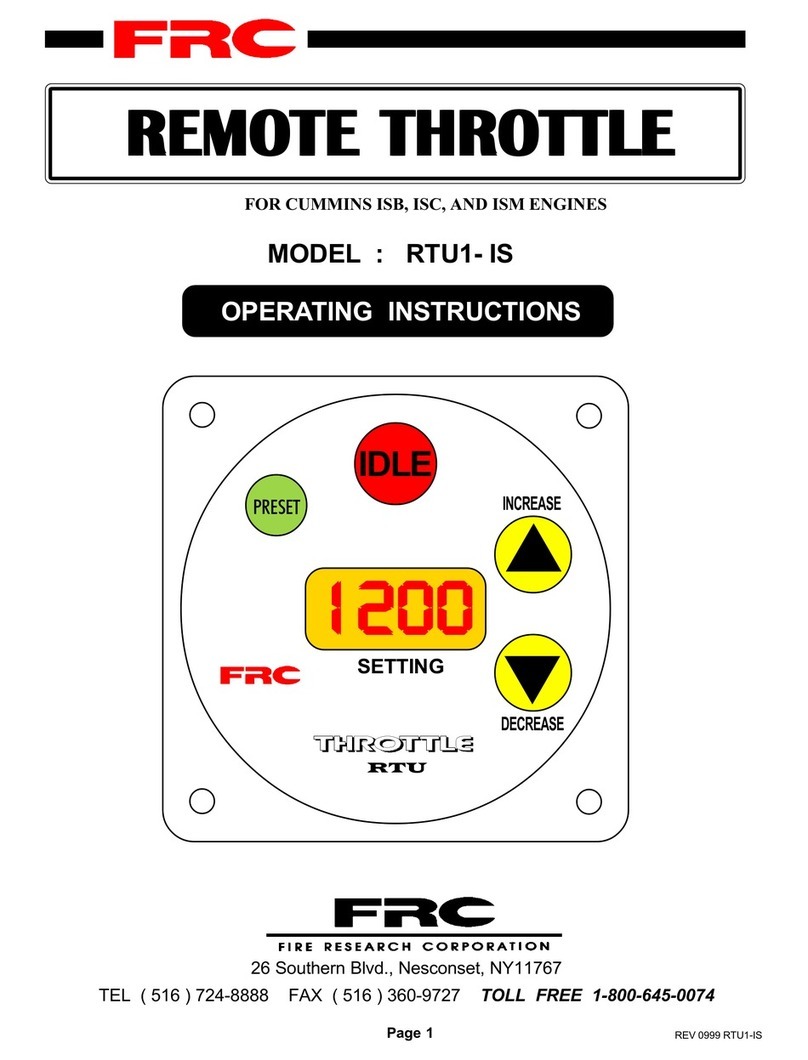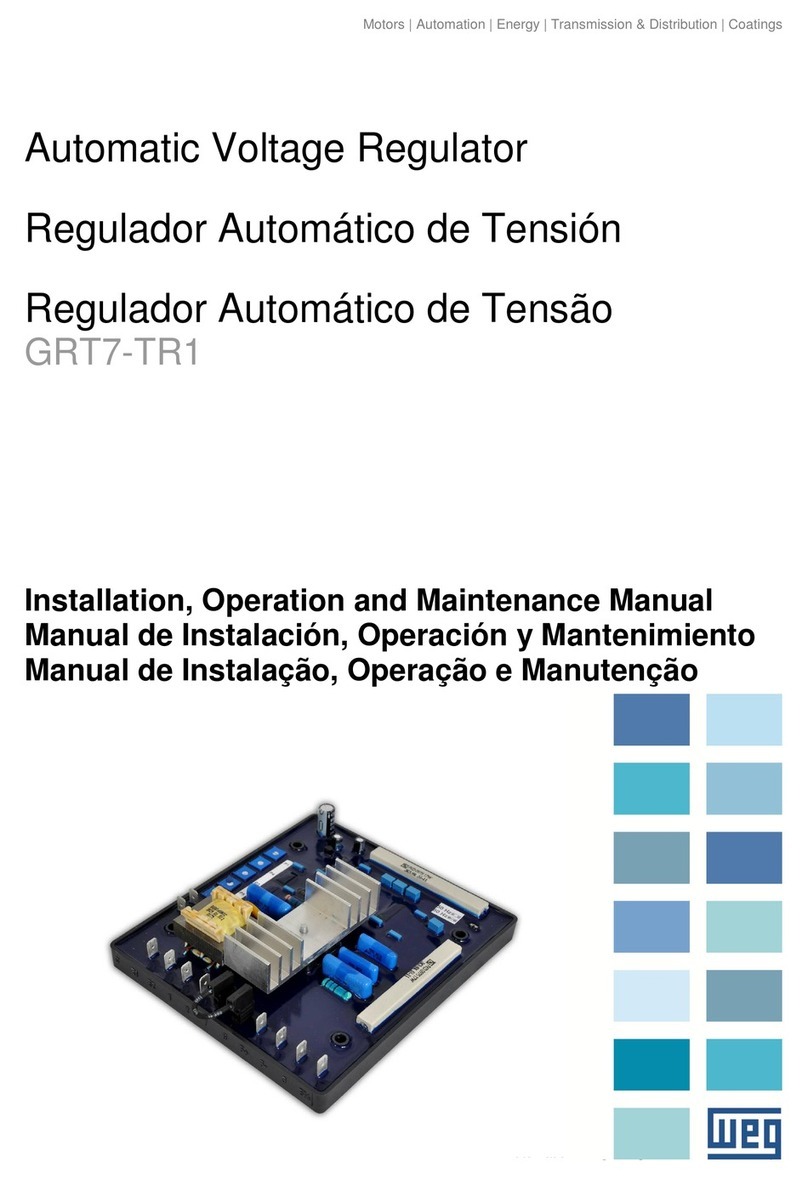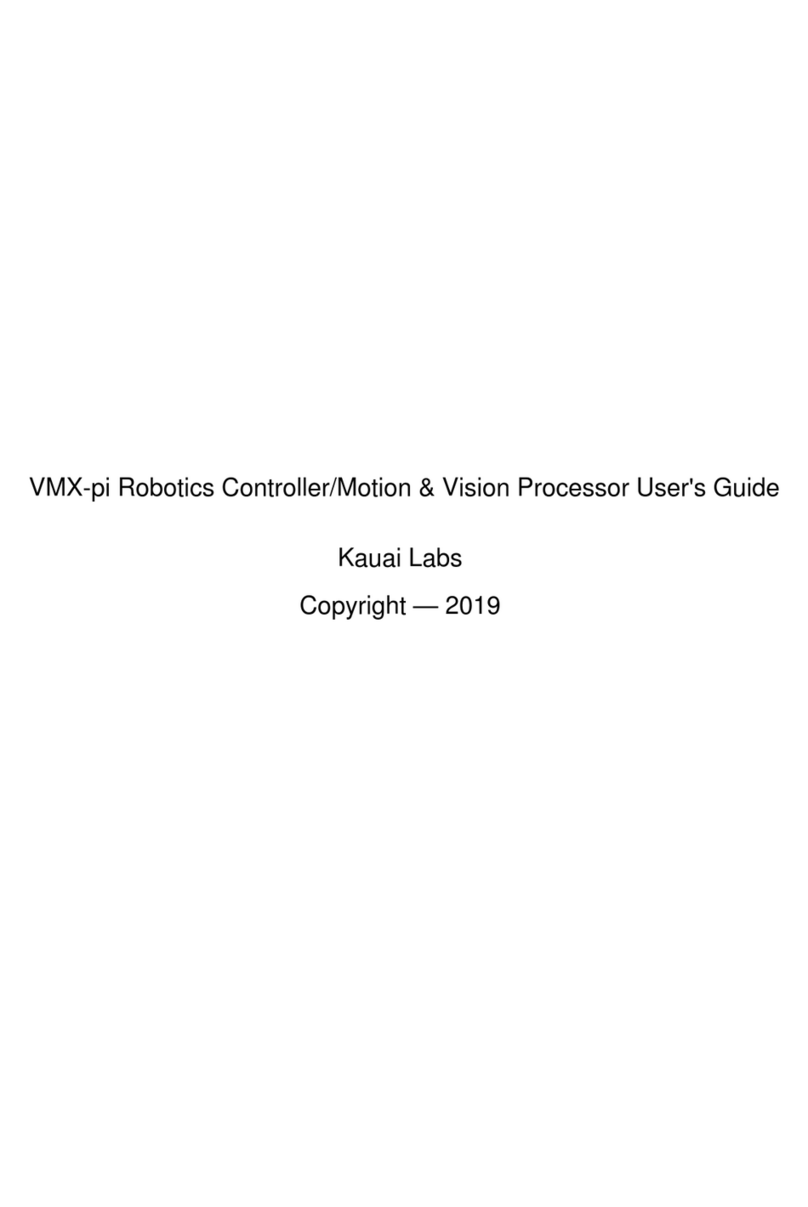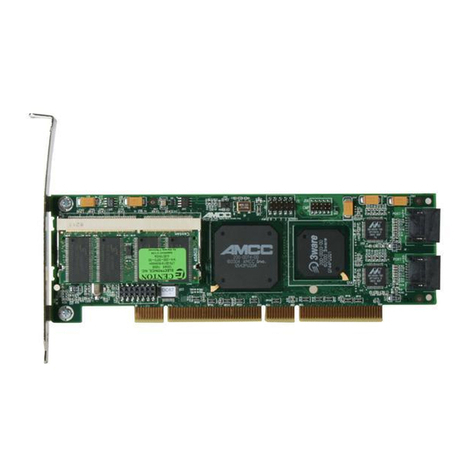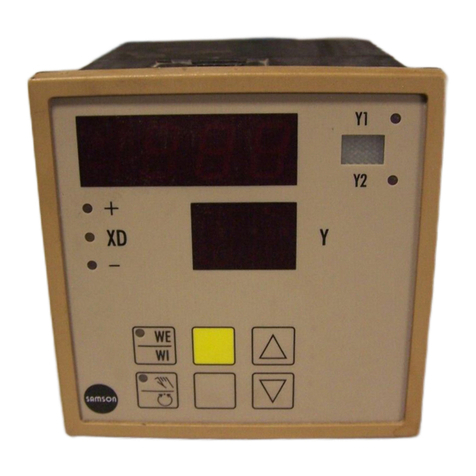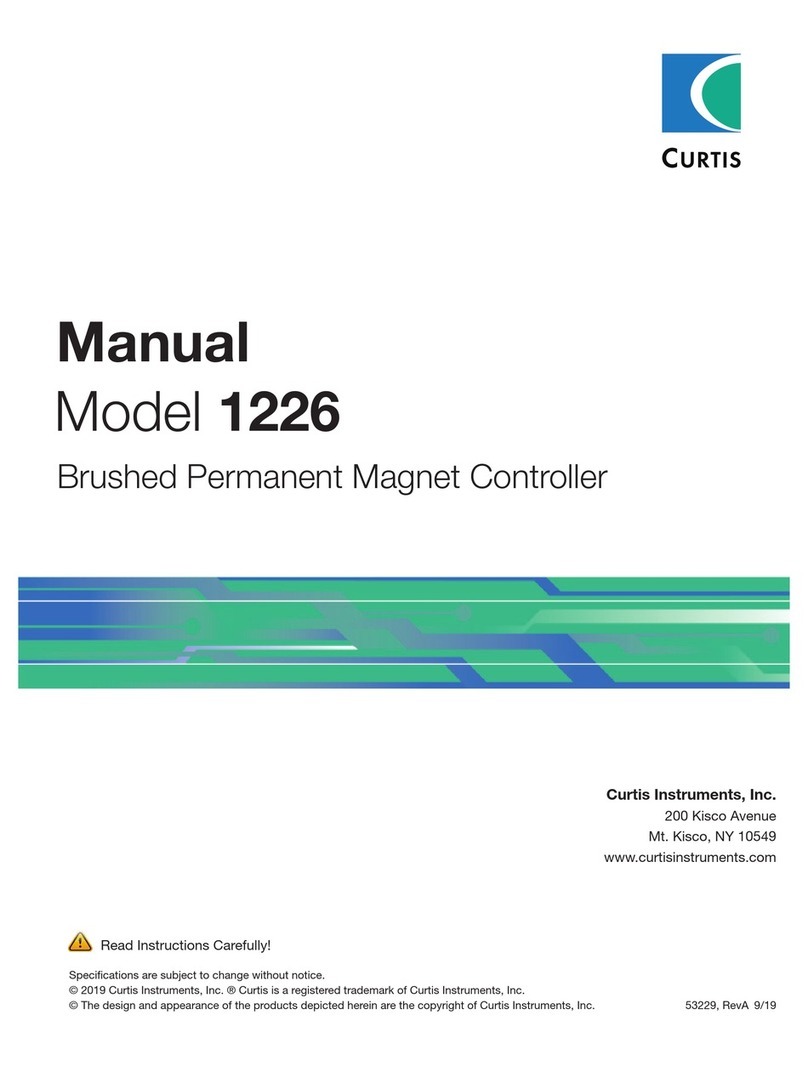Nordmann Engineering NDP User manual

Kanalfeuchteregler mit Feuchtesensor NDC
Duct humidity controller with humidity sensor NDC
Régulateur d’humidité pour gaine avec sonde d’humidité NDC
Nordmann NDP
2561657 DE/EN/FR 1304
INSTALLATIONS- UND BEDIENUNGSANLEITUNG
INSTALLATION AND OPERATING INSTRUCTIONS
INSTRUCTIONS D’INSTALLATION ET D’EXPLOITATION
NORDMANN
ENGINEERING
NORDMANN
ENGINEERING
Dampfluftbefeuchter econoVap

2
1 Funktionsbeschreibung
Der PI-Feuchteregler Nordmann NDP dient
zusammen mit dem Kanalfeuchtesensor Nord-
mann NDC zur Feuchteregelung in einem
Lüftungskanal. Das Sensor-Ausgangssignal,
sowie das Ein- und Ausgangssignal des Reg-
lers (0…10 VDC, 0…20 mA oder 2…10 VDC,
4…20 mA) sind über Jumper einstellbar.
2 Sicherheit
Beachten Sie bitte alle lokalen Vorschriften
betreffend die Ausführung von elektrischen
Installationen.
Die Installationsarbeiten dürfen nur durch
ausgewiesenes Fachpersonal (Elektriker
oder Fachkraft mit gleichwertiger Ausbil-
dung) durchgeführt werden.
Achtung Stromschlaggefahr! Vor Beginn
der Installationsarbeiten ist das Gerät, an das
der Nordmann NDP angeschlossen werden
soll, vom Stromnetz zu trennen. Der Wieder-
anschluss an das Stromnetz darf erst nach
Fertigstellung sämtlicher Installationsarbeiten
erfolgen.
Achtung! Die elektronischen Bauteile im
Innern des Nordmann NDP, des Nordmann
NDC sowie des Befeuchters sind sehr emp-
ndlich gegen elektro statische Entladungen.
Zum Schutz dieser Bauteile müssen für alle
Installationsarbeiten Massnahmen gegen
Beschädigung durch elektrostatische Entla-
dung (ESD–Schutz) getroffen werden.
3 Lieferumfang
Der Lieferumfang umfasst:
– PI-Feuchteregler Nordmann NDP
– Feuchtefühler Nordmann NDC
– Kabelverschraubung
– Befestigungsmaterial
– Installations und Bedienungsanleitung
4 Platzierung
Feuchteregler Nordmann NDP
Montieren Sie den Feuchteregler Nordmann
NDP mindestens 1,5 m über dem Fussboden
an einer geschützten und für die Bedienung
geeigneten Stelle an die Wand (Aufputz- oder
Unterputzdose).
Feuchtefühler Nordmann NDC
Der Feuchtefühler Nordmann NDC wird direkt
an den Kanal montiert.
Platzierung im Abluftkanal (empfohlen):
Platzieren sie den Nordmann NDC im Ab-
luftkanal so nah wie möglich beim Lufteintritt,
aber immer nach einem allenfalls vorhanden
Ventilator im Abluftkanal.
Platzierung im Zuluftkanal: Platzieren sie
den Nordmann NDC im Zuluftkanal min-
destens 3 Meter nach einem Ventilator oder
einem Heizregister und mindestens in einem
Abstand von 5x der Befeuchtungsstrecke
zum Dampfverteiler (siehe Anleitung zum
Befeuchter).
1 Functional description
PI humidity controller Nordmann NDP serves
together with the duct humidity sensor Nord-
mann NDC for the humidity control in air ducts.
The output signal of the sensor as well as the
input and output signal of the controller (0…10
VDC, 0…20 mAor 2…10 VDC, 4…20 mA)
may be customized by jumpers.
2 Safety
Please observe all local regulations concern-
ing the electric installation.
The installation work must be performed
only by adequately qualied personnel
(electrician or workman with equivalent
training).
Warning - danger of electric shock! Before
starting the installation work the unit to which
the Nordmann NDP will be connected must
be disconnected from the mains and may be
reconnected to mains only after all installation
work has been completed.
Warning! The electronic components inside
the Nordmann NDP, the Nordmann NDC
and the humidier are very susceptible to
electrostatic discharges. For the protection
of these components, measures must be
taken during all installation work to prevent
damage caused by electrostatic discharge
(ESD–protection).
3 Delivery
The delivery includes:
– PI humidity controller Nordmann NDP
– Humidity sensor Nordmann NDC
– Cable gland
– Fixing material
– Installation and operating instructions
4 Mounting location
Humidity controller Nordmann NDP
Install the humidity controller in a protected and
easy accessible place at least 1.5 m above the
oor to the wall (mounting on ush-mounting
or wall-mounting box).
Humidity sensor Nordmann NDC
The humidity sensor Nordmann NDC is in-
stalled directly on the duct.
Mounting in a return air duct (recom-
mended): Mount the Nordmann NDC in a
return air duct close to the air outlet of the
room but downstream from a return fan if
one is present.
Mounting in a supply air duct: Mount the
Nordmann NDC in a supply air duct at least
three meters downstream from the nearest
fan and coil and with a minimum distance of
5x the humidication distance to the steam
distributor (see manual of the humidier).
1 Description de fonctionnement
Le régulateur d’humidité PI Nordmann NDP
sert avec la sonde d’humidité Nordmann NDC
à la régulation d’humidité dans une gaine de
ventilation. Par le biais de cavaliers, on peut
régler le signal de sortie de la sonde ainsi
que le signal d’entrée et le signal de sortie
du régulateur (0…10 VDC, 0…20 mAou
2…10 VDC, 4…20 mA).
2 Sécurité
Veuillez observer chaque prescription lo-
cale concernent l’exécution d’installations
électriques.
Seules les personnes spécialisées compé-
tentes (électricien ou spécialiste de même
formation) sont autorisées à effectuer les
travaux d’installation.
Attention, risque de choc électrique! Avant
de commencer des travaux d’installation, sé-
parer du réseau électrique l’appareil destiné à
être raccordé à le Nordmann NDP. N’effectuer
le raccordement de l’humidicateur au réseau
électrique qu’au terme de tous les travaux
d’installation.
Attention! Les composants électroniques
intégrés dans le Nordmann NDP, le Nordmann
NDC et l’humidicateur sont très sensibles
aux décharges électrostatiques. Ces com-
posants impliquent, lors de tous les travaux
d’installation, la prise des mesures de pré-
caution contre leur détérioration par décharge
électrostatique.
3 Ampleur de la livraison
La livraison comporte:
– Régulateur d’humidité PI Nordmann NDP
–Sonde d’humidité NDC
– Presse-étoupe
– Matériel de xation
– Instructions d’installation et d’exploitation
4 Emplacement
Régulateur d’humidité Nordmann NDC
Le montage du régulateur d’humidité Nord-
mann NDP s’effectue à la paroi (montage en
boîtier apparent ou boîtier encastré), 1,5 m
au moins au-dessus du plancher, à un endroit
protégé et accessible pour l’utilisation.
Sonde d’humidité Nordmann NDC
Le montage de la sonde d’humidité Nordmann
NDC s’effectue directement dans la gaine.
Emplacement dans la gaine d’évacuation
d’air (recommandé): placez le Nordmann
NDC dans la gaine d’évacuation d’air, le plus
près possible de la sortie de local, toutefois
toujours après un ventilateur disposé dans la
gaine d’évacuation d’air.
Emplacement dans la gaine d’admission
d’air: placez le Nordmann NDC dans la gaine
d’admission d’air à 3 mètres au moins d’un
ventilateur ou d’un dispositif de chauffage
et à une distance minimale de 5 fois la dis-
tance d’absorption de la rampe de diffusion
de vapeur (consulter le manuel concernant
l’humidicateur).

3
5 Installation
Feuchteregler Nordmann NDP
1. Schraube des Gehäuses lösen und Mon-
tageplatte mit derAnschlusseinheit entfer-
nen.
3. Anschlusskabel gemäss dem Elektro-
schema an dieAnschlussklemmen ansch-
liessen.
3. Montageplatte (mit der Plastikschraube
nach unten zeigend) am vorgesehenen Ort
mit zwei Schrauben in der Unterputz- oder
Aufputzdose befestigen (siehe Masszeich-
nung).
4. Gehäuse vorsichtig auf die Montageplatte
aufstecken und mit der Schraube befesti-
gen (Schraube nur mässig anziehen).
Feuchtefühler Nordmann NDC
1. Am vorgesehenen Ort in den Kanal ein
Loch Durchmesser 16 mm (5/8"), sowie
vier Löcher für die Selbstbohrschrauben
bohren (siehe Masszeichnung).
2. Schraube des Gehäusedeckels lösen und
Deckel entfernen.
3. Anschlusskabel durch die Kabeldurchfüh-
rung ins Gerät führen und gemäss dem
Elektroschema an dieAnschlussklemmen
anschliessen.
4. Dichtung auf der Sensorseite zentrisch auf
das Gehäuse kleben (selbstklebend).
5. Sensor in die Bohrung im Kanal einschie-
ben. Anschliessend Gehäuse mit den vier
mitgelieferten Selbstbohrschrauben am
Kanal befestigen.
6. Gehäusedeckel wieder in die Scharniere
des Gehäuses einschnappen, Gehäuse-
deckel schliessen und mit der Schraube
befestigen (Schraube nur mässig anzie-
hen).
6 Produktspezikationen
6.1 Technische Daten
Nordmann NDP
Stromversorgung / Power Supply / Alimentation de courant
Betriebsspannung / Operating voltage / Tension d’alimentation 24 V AC 50/60 Hz ± 10%, 24VDC ± 10%
Leistungsaufnahme / Power Consumption / Puissance absorbée Max. 3 VA
Klemmenanschlüsse / Terminal Connectors / Bornes Für Litzen / for wires / pour ls 0.34…2.5 mm2
(AWG 24…12)
Signaleingänge / Signal Inputs / Entrées de signal
Universaleingänge / Universal Inputs / Entrées universelles UI1, UI2
Signalausgänge / Signal Outputs / Sorties de signal
Analogausgang / Analog Output / Sortie analogique AO1
Ausgangssignal / Output Signal / Signal de sortie 0...10 VDC oder / or / ou 0…20mA
Auösung / Resolution / Résolution 39 mV oder / or / ou 0.078 mA
Maximale Last / Maximum Load / Charge maximum 10 mA (bei / at / à 0...10 VDC)
20 mA (bei / at / à 0…20mA)
5 Installation
Régulateur d’humidité Nordmann NDP
1. Desserrer la vis du boîtier et ôter la plaque
de montage avec le bloc de raccorde-
ment.
2. Brancher les câbles de raccordement aux
bornes de raccordement selon le schéma
électrique.
3. A l’endroit prévu, xer la plaque de montage
(vis de plastique orientée vers le bas) sur
le boîtier apparent ou le boîtier encastré
au moyen de 2 vis (consulter le dessin
coté).
4. Placer précautionneusement le boîtier sur
la plaque de montage et le xer à l’aide
de la vis (ne la serrer que modérément).
Sonde d’humidité Nordmann NDC
1. Dans la gaine, percer un trou de 16 mm
(5/8") à l’endroit désiré ainsi que les 4
trous pour vis autoperceuses (consulter
le dessin coté).
2. Desserrer la vis du couvercle de boîtier et
ôter le couvercle.
3. Introduire le câble de raccordement dans
l’appareil par la traversée de câble et le
brancher aux bornes de raccordement
selon le schéma électrique.
4. Coller le joint sur la face de la sonde en
ayant soin de le centrer (autocollant).
5. Introduire la sonde dans l’alésage du canal.
Ensuite, xer le boîtier à la gaine à l’aide
des 4 vis autoperceuses livrées.
6. Positionner le couvercle dans le logement
de boîtier, fermer le couvercle et le xer à
l’aide de la vis (ne la serrer que modéré-
ment).
6 Spécicationsdesproduits
6.1 Caractéristiques techniques
Nordmann NDP
5 Installation
Humidity controller Nordmann NDP
1. Open the screw of the housing and remove
mounting plate with the connecting unit.
2. Connect wires of the connection cables
to the terminals according to the wiring
diagram.
3. At the place of location x mounting
plate (plastic screw facing downwards)
with two screws to the ush-mounting
or wall-mounting box (see dimensional
drawing).
4. Carefully snap housing onto the mount-
ing plate, and x it with the screw (do not
tighten screw too much).
Humidity sensor Nordmann NDC
1. At the place of location drill a hole with a
diameter of 16mm (5/8") as well as 4 holes
for the self tapping screws into the duct.
2. Open the screw on the housing cover and
remove cover.
3. Lead connecting cable through the cable
gland and connect wires to the terminals
according to the wiring diagram.
4. Attach gasket to the sensor side of the
housing (self-adhesive).
5. Insert the probe into the hole in the duct,
then x housing to the duct using the 4
self-tapping screws provided.
6. Snap cover into the hinge of the housing,
then close cover and x it with the screw
(do not tighten screw too much).
6 Productspecications
6.1 Technical data
Nordmann NDP

4
Umgebung / Environment / Environnement
Betrieb / Operation / Exploitation IEC 721-3-3
Klimatische Bedingungen / Climatic Conditions / Conditions climatiques Class 3 K5
Temperatur / Temperature / Température 0…50 °C (32…122 °F)
Feuchtigkeit / Humidity / Humidité <95 %rF nicht kondensierend / <95 %rh non-
condensing /<95 %hr sans condensation
Transport & Lagerung / Transport & Storage / Transport & entreposage IEC 721-3-2 und / and / et IEC 721-3-1
Klimatische Bedingungen / Climatic Conditions / Conditions climatiques Class 3 K3 und / and / et Class 1 K3
Temperatur / Temperature / Température -25…70 °C (-13…158 °F)
Feuchtigkeit / Humidity / Humidité <95 %rF nicht kondensierend / <95 %rh non-
condensing /<95 %hr sans condensation
Mechanische Bedingungen / Mechanical Conditions / Conditions mécaniques Class 2M2
Standards / Standards / Standard
Konform mit / conform according to / conforme selon
EMC Standard 89/336/EEC EMEI Standard 73/23/EEC
EN 61 000-6-1/ EN 61 000-6-3
Normen Produkt / Product standards / Normes de produit
Automatische elektrische Steuerungen für Haushalt und ähnlichen Gebrauch /
Automatic electrical controls for household and similar use /
Commandes électriques automatiques pour le ménage et l’usage semblable
EN 60 730 –1
Spezielle Anforderung an temperaturabhängige Steuerungen /
Special requirement on temperature dependent controls /
Exigences spéciales concernant sur des commandes à charge de la température
EN 60 730 – 2 - 9
Schutzart gemäss EN 60529 / Degree of Protection to EN 60529 /
Genre de protection selon EN 60529
IP30
Sicherheitsklasse / Safety Class / Classe de sécurité III (IEC 60536)
Allgemein / General / En général
Gehäuse und Gehäusedeckel / Housing and Cover / Boîtier et couvercle de boîtier ABS feuerfest / ABS re proof / ABS non
inammable (UL94 class V-0)
Montageplatte / mounting plate / Plaque de montage Galvanisierter Stahl / Galvanised steel / Acier
galvanisé
Dimensionen Frontteil (HxBxT) / Dimensions front part (HxWxD) /
Dimensions partie frontale (HxLxP)
88 mm x 88 mm x 21 mm (3.5" x 3.5" x 0.8")
Dimensionen Anschlussteil / Dimensions connecting unit /
Dimensions unité de raccordement
ø 58 mm x 32 mm (ø 2.3 x 1.3")
Gewicht (inkl. Verpackung) / Weight (including package) / Poids (avec emballage) 260 g (9.2 oz)
6.2 Technische Daten
Nordmann NDC
Stromversorgung / Power Supply / Alimentation de courant
Betriebsspannung / Operating voltage / Tension d’alimentation 24 V AC 50/60 Hz ± 10%, 24VDC ± 10%
Leistungsaufnahme / Power Consumption / Puissance absorbée Max. 2 VA
Klemmenanschlüsse / Terminal Connectors / Bornes Für Litzen / for wires / pour ls 0.34…2.5 mm2
(AWG 24…12)
Sensorelement / Sensor probe / Elément de sonde
Messelement / Measuring element / Elément de mesure Kapazitives Messelement / Capacitive measur-
ing element / Elément de mesure capacitif
Messbereich / Measuring range / Plage de mesure 0…100 %rF / %rh / %hr
Messgenauigkeit / Measuring Accuracy / Fidélité de mesure
100
0
±1
±2
±3
±4
±5
%rF
%rh
%hr
%rF
%rh
%hr
20 30 40 50 60 70 80 90 100
Max. rF-Toleranz bei 25 °C (77°F)
Max. RH tolerance at 25 °C (77°F)
Tolérance HR max. à 25 °C (77°F)
Hysterese / Hysteresis / Hystérésis ± 1%
Wiederholbarkeit / Repeatability / Reproductibilité ± 0.1%
Stabilität / Stability / Stabilité < 0.5% / Jahr / year / année
6.2 Technical data
Nordmann NDC
6.2 Caractéristiques techniques
Nordmann NDC

5
Signalausgänge / Signal Outputs / Sorties de signal
Analogausgänge / Analog Outputs / Sorties analogiques H OUT
Ausgangssignal / Output Signal / Signal de sortie 0...10 VDC, 0…20mA, 2...10 VDC, 4…20mA
Auösung / Resolution / Résolution 10 Bit, 9.7 mV, 0.019.5 mA
Maximale Last / Maximum Load / Charge maximum 20 mA, 500Ω
Umgebung / Environment / Environnement
Betrieb / Operation / Exploitation IEC 721-3-3
Klimatische Bedingungen / Climatic Conditions / Conditions climatiques Class 3 K5
Temperatur / Temperature / Température -40…70°C (-40…158°F)
Feuchtigkeit / Humidity / Humidité <95 %rF nicht kondensierend / <95 %rh non-
condensing /<95 %hr sans condensation
Transport & Lagerung / Transport & Storage / Transport & entreposage IEC 721-3-2 und / and / et IEC 721-3-1
Klimatische Bedingungen / Climatic Conditions / Conditions climatiques Class 3 K3 und / and / et Class 1 K3
Temperatur / Temperature / Température -40…80°C (-40…176°F)
Feuchtigkeit / Humidity / Humidité <95 %rF nicht kondensierend / <95 %rh non-
condensing /<95 %hr sans condensation
Mechanische Bedingungen / Mechanical Conditions / Conditions mécaniques Class 2M2
Standards / Standards / Standard
Konform mit / conform according to / conforme selon
EMC Standard 89/336/EEC EMEI Standard 73/23/EEC
EN 61 000-6-1/ EN 61 000-6-3
Normen Produkt / Product standards / Normes de produit
Automatische elektrische Steuerungen für Haushalt und ähnlichen Gebrauch /
Automatic electrical controls for household and similar use /
Commandes électriques automatiques pour le ménage et l’usage semblable
EN 60 730 –1
Spezielle Anforderung an temperaturabhängige Steuerungen /
Special requirement on temperature dependent controls /
Exigences spéciales concernant sur des commandes à charge de la température
EN 60 730 – 2 - 9
Schutzart gemäss EN 60529 / Degree of Protection to EN 60529 /
Genre de protection selon EN 60529
IP60
Montierter Sensor unten mit AMS-1 / Mounted probe down with AMS-1 /
Sonde montée vers le bas avec AMS-1
IP63
Sicherheitsklasse / Safety Class / Classe de sécurité III (IEC 60536)
Allgemein / General / En général
Gehäuse und Gehäusedeckel / Housing and Cover / Boîtier et couvercle de boîtier PC+ABS (UL94 class V-0)
Filtermaterial / Filter material / Matériel de ltre PTFE coated 1μm pores
Dimensionen Sensorgehäuse (HxBxT) / Dimensions (HxWxD) sensor housing /
Dimensions boîtier de sonde (HxLxP)
68 mm x 91 mm x 47 mm (2.7” x 3.7” x 1.9”)
Dimensionen Sensor / Dimensions Probe / Dimensions sonde ø 14 mm x 157 mm (ø 0.55 x 6.2”)
Gewicht NDC (inkl. Verpackung) / Weight NDC (including package) /
Poids NDC (avec emballage)
260 g (9.2 oz)
6.3 Dimensionen
Nordmann NDP [mm] (")
6.3 Dimensions
Nordmann NDP [mm] (")
6.3 Dimensions
Nordmann NDP [mm] (")
88 (3.5)
88 (3.5)
21 (0.8)
ø58 (ø2.3)
32 (1.2)

6
NDP
GND / 0V
1
12345678
24V
2345
AO1
6
UI1
7
UI2
8
24 V AC/DC ±10%
0V / GND
0...10 VDC/0...20 mA
0V / GND
0...10 V
0...20mA
0...10 V
0...20mA
AO UI2
0...10 V
0...20mA
RT or Dry-Contact
RT or Dry-Contact
UI1
NDC
24V AC/DC
1
0V / GND
2
H OUT
3
STATUS
LED
JP1 JP3
JP1
Signaltyp
Signal type
Type de signal
3
2
1
U1
0-10V, 2-10V
3
2
1
I1
0-20mA, 4-20mA
JP3
Signalbereich
Signal range
Plage de signal
3
2
1
U1: 0-10V
I1: 0-20mA
3
2
1
U1: 2-10V
I1: 4-20mA
Status LED
brennt nicht: keine Spannung
5 s Blinken: Normal
1 s Blinken: Sensorelement defekt
No light: no power
5 s blinking: Normal
1 s blinking: Sensor element defective
ne brûle pas: pas d’alimentation de tension
5 s clignoter: Normal
1 s clignoter: Elément de sonde defectueuse
Nordmann NDC [mm] (")
6.4 Elektroschema/Konguration
Nordmann NDC [mm] (")
6.4 Wiringdiagram/Conguration
Nordmann NDC [mm] (")
6.4 Schémaélectrique/Conguration
ø14 x 157
(ø0.55 x 6.2)
47 (1.9) 91 (3.6)
68 (2.7)
ø14 (0.6)
74.5 (2.9)
54 (2.1)
ø16 (0.62)

7
7 Anschluss des NDP
am Nordmann ES4
1. Den Sensor Nordmann NDC gemäss dem
untenstehenden Schema an den Regler
NDP und an eine 24 VAC/DC Spannungs-
versorgung anschliessen (z.B. an das
optional zum Nordmann ES4 erhältliche
24 V DC Netzteil). Anschliessend mit den
Jumper “JP1” und “JP3” auf dem Print des
Sensors das Regelsignal auf “0-10V”
einstellen.
2. Den Regler Nordmann NDP gemäss dem
untenstehenden Schema an die entspre-
chenden Klemmen auf dem Leistungsprint
des Nordmann ES4 und an eine 24 V AC/
DC Spannungsversorgung anschliessen
(z.B. an das optional zum Nordmann ES4
erhältliche 24 V DC Netzteil). Anschlie-
ssend mit den Jumpern “AO” und “AI” das
Eingangssignal und das Ausgangssignal
des Reglers auf “0-10V” einstellen.
3. Den Regler Nordmann NDP auf den
gewünschten Feuchtesollwert einstellen
(siehe nachfolgende Programmieranlei-
tung).
7 Connecting the NDP
to the Nordmann ES4
1. Connect the Nordmann NDC humidity
sensor to the Nordmann NDP controller
and to an external 24 VAC/VDC power
supply (e.g. to the optional 24 V DC power
supply available for the Nordmann ES4)
according to the wiring diagram below.
Then, set the control signal to “0-10V”
using the jumpers “JP1” and “JP3” on the
control board of the sensor.
2. Connect the Nordmann NDP controller to
the appropriate terminal block located on
the driver board of the Nordmann ES4 and
to an external 24 VAC/VDC power supply
(e.g. to the optional 24 V DC power supply
available for the Nordmann ES4) according
to the wiring diagram below. Then, set the
input and the output signal of the control-
ler to “0-10V” using the Jumper “AO” and
“AI”.
3. Set the Nordmann NDP controller to the
desired humidity setpoint (see following
programming instructions).
7 Raccordement du NDP
au Nordmann ES4
1. Brancher la sonde d’humidité Nordmann
NDC selon le schéma électrique ci-dessous
au régulateur Nordmann NDP et à une
alimentation électrique 24 VAC/DC (p.ex.
au bloc d’alimentation 24 V DC optionnel
disponibles pour le Nordmann ES4). Puis,
régler le signal de commande à “0-10V”
par l’intermédiaire du cavalier “JP1” et
“JP3” sur la platine de la sonde.
2. Brancher le régulateur Nordmann NDP
selon le schéma électrique ci-dessous
aux bornes correspondantes de la platine
de puissance du Nordmann ES4 et à une
alimentation électrique 24 VAC/DC (p.ex.
au bloc d’alimentation 24 V DC optionnel
disponibles pour le Nordmann ES4). Puis,
régler le signal d’entrée et le signal de sortie
du régulateur à “0-10V” par l’intermédiaire
du cavalier “AO” et “AI”.
3. Régler le régulateur Nordmann NDP sur
la valeur hygrométrique de consigne
désirée (voir instructions de programma-
tion suivantes).
CONT.SIGN
V+ IN GND
X2 X3
VD
MAIN SUPPLY
L1 NSC1SC2
X1
On/Off Mode
JP1
Nordmann ES4
Leistungsprint
Power board
Platine de puissance
kein Jumper
No jumper
Pas de cavalier
Sicherheitskette
Safety circuit
Chaîne de sécurité
min. Querschnitt pro Litze 1 mm2
min. cross section per wire 1 mm2
Section min. par fil 1 mm2
∆p
Strömungswächter
Air flow monitor
Contôleur flux d’air
200-240 V / 50...60 Hz
Feuchtewächter
Humidity monitor
Contrôleur d'humidité
max. Querschnitt pro Litze 0.5 mm2
max. cross section per wire 0.5 mm2
Section max. par fil 0.5 mm2
0...10V
2
3
1
2
3
1
***
JP1 JP3
8
7
UI2
6
5
4
3
2
1
UI1
AO1
24 V
0V/GND
NDP
Regler
Controller
Régulateur
**
0...10 V
0...20mA
RT or Dry-Contact
RT or Dry-Contact
UI1 UI2
0...10 V
0...20mA
0...10 V
0...20mA
AO
0...10V
**
0...10 V
0...20mA
RT or Dry-Contact
UI1
0...10 V
0...20mA
AO
24V AC/DC
0V/GND
H OUT
2
3
1
2
3
1
***
1 2 3
NDC
Sensor
Sensor
Sonde
JP1 JP3
0V/GND
24V AC/DC
max. Querschnitt pro Litze 0.5 mm2
max. cross section per wire 0.5 mm2
Section max. par fil 0.5 mm2

8
8.2 Switching the humidity
controller on and off
Press the <On/Off> key to switch the humidity
controller on or off.
– Controller switched off:
– Controller switched on:
8.2 Feuchteregler
ein- und ausschalten
<Ein/Aus>-Taste drücken, um den Feuch-
teregler ein- oder auszuschalten.
– Regler ausgeschaltet:
– Regler eingeschaltet:
8.2 Enclencher et déclencher
le régulateur d’humidité
Presser sur la touche <On/Off>, pour enclen-
cher ou déclencher le régulateur d’humidité.
– Régulateur déclenché:
– Régulateur enclenché:
8 Bedienung des NDP
8.1 Anzeige- und
Bedienelemente
8 Operating the NDP
8.1 Display and
operating elements
8 Servir le NDP
8.1 Elémentsd’afchageet
de commande
Aktuelle Feuchtigkeit in %rF
Actual humidity in %rh
Humidité actuelle en %hr
Aktuelle Zeit
Actual time of day
Heure actuelle
oder / or / ou
Eingestellte Sollfeuchtigkeit in %rF
Set humidity in %rh
Humidité réglée en %hr <Up>-Taste
<Up> key
Touche <Up>
<Enter>-Taste
<Enter> key
Touche <Enter>
<Down>-Taste
<Down> key
Touche <Down>
Ausgang aktiv
Output aktiv
Sortie active
<Ein/Aus>-Taste
<On/Off> key
Touche <On/Off>
aktiver Betriebsmodus
active operating mode
mode d’exploitation actif
Timer läuft
Timer running
Timer court
40.0
OFF
%40.0
OFF
%40.0
OFF
%
40.0
08.56
%40.0
08.56
%40.0
08.56
%

9
8.3 Uhrzeit und Wochentag einstellen
Vorraussetzung für die korrekte Funktion des
Feuchtereglers (speziell der Timerfunktion) ist,
dass die Uhrzeit und der Wochentag richtig
eingestellt sind. Dazu wie folgt vorgehen:
1. Das Gerät mit der <Ein/Aus>-Taste
einschalten.
2. Die <Enter>-Taste ca. 3 Sekunden
lang drücken bis “SEL” in der Anzeige
erscheint.
3. Mit der <Up>- oder <Down>-Taste die
Uhrzeit anwählen und anschliessend die
<Enter>-Taste drücken.
4. Die Minutenanzeige blinkt. Mit der <Up>-
oder <Down>-Taste die Minuten einstel-
len und mit der <Enter>-Taste bestätigen.
5. Die Stundenanzeige blinkt. Mit der <Up>-
oder <Down>-Taste die Stunde einstellen
und mit der <Enter>-Taste bestätigen.
6. Der Wochentag blinkt. Mit der <Up>- oder
<Down>-Taste den Wochentag einstellen
(Montag = day1, Dienstag = day2 etc.)
und mit der <Enter>-Taste bestätigen.
7. Um den Setup-Mode zu verlassen 2 mal
kurz <Ein/Aus>-Taste drücken.
Diese Einstellung braucht nur einmal gemacht
zu werden. Eine interne Batterie sorgt für die
unterbrechungsfreie Spannungsversorgung.
8.4 Feuchtesollwert einstellen
Um den Feuchtesollwert einzustellen wie
folgt vorgehen:
1. Das Gerät mit der <Ein/Aus>-Taste
einschalten.
2. Mit der <Up>- oder <Down>-Taste den
gewünschten Feuchtesollwert in %rF
einstellen.
8.5 Betriebsmodus wählen
Der Feuchteregler kann entweder im Stan-
dardmodus (Regelung erfolgt auf den ein-
gestellten Sollfeuchtewert) oder im ECO
Modus (Regelung erfolgt auf einen xen
Sollfeuchtewert von 30 %rF) betrieben wer-
den.Um den Betriebsmodus festzulegen wie
folgt vorgehen:
1. Das Gerät mit der <Ein/Aus>-Taste ein-
schalten.
2. <Ein/Aus>-Taste kurz drücken um zwi-
schen den beiden Betriebsmodi umzu-
schalten. Der gewählte Betriebsmodus
wird durch das entsprechende Symbol
in der Anzeige angezeigt:
Standardmodus
ECO Modus
8.3 Setting time and day of week
Proper functioning of the controller (specially
the timer function) requires the time and the
day of the week to be set correctly. Proceed as
follows to set the time and the day of the week:
1. Press the <On/Off> key to switch the unit
on.
2. Press the <Enter> key for about 3 seconds
“SEL” appears in the display.
3. Select the time setting option using the
<Up> or <Down> key, then conrm with
the <Enter> key.
4. The minute display ashes. Press the
<Up> or <Down> key to set the minutes,
then conrm with the <Enter> key.
5. The hours display starts ashing. Press
the <Up> or <Down> key to set the cur-
rent hour, then conrm with the <Enter>
key.
6. The day of the week ashes. Press the
<Up> or <Down> key to set the day of
the week (Monday = day1, Tuesday =
day2, and so on), then conrm with the
<Enter> key.
7. To quit the setup mode, briey press the
<On/Off> key twice.
The above settings need to be carried out
just once as an internal battery preserves the
settings even in case of power failure.
8.4 Setting the humidity setpoint
Proceed as follows to set the humidity setpoint:
1. Press the <On/Off> key to switch the unit
on.
2. Press the <Up> or <Down> key to set the
humidity setpoint to the desired value in
%rh.
8.5 Selecting the operating mode
The humidity controller can be operated either
in Standard mode (regulation takes place on
the set humidity setpoint value) or ECO Mode
(regulation takes place on preset humidity
setpoint value of 30 %rh). Proceed as follows
to select the operating mode:
1. Press the <On/Off> key to switch the unit
on.
2. Briey press the <Enter> key in order to
switch between the two operating modes.
Acorresponding symbol in the display
indicates the currently selected operating
mode:
Standard mode
ECO Mode
8.3 Régler l’heure et le jour
Pour un fonctionnement correct du régulateur
(spécialement la fonction de temporisation),
l’heure et le jour doivent être correctement
réglés. Pour ce faire:
1. Allumerl’appareilaveclatouche<On/Off>.
2. Presser env. 3 secondes sur la touche
<Enter> jusqu’à ce que “SEL” apparaisse
sur l’écran.
3. Régler l’heure en appuyant sur les touches
<Up> ou <Down>, puis presser la touche
<Enter>.
4. L’afchage des minutes commence à
clignoter. Régler celles-ci au moyen des
touches <Up> ou <Down> et conrmer
avec la touche <Enter>.
5. L’afchage de l’heure commence à cli-
gnoter. Régler l’afchage de l’heure au
moyen des touches <Up> ou <Down>
et conrmer avec la touche <Enter>.
6. L’afchage du jour commence à cligno-
ter. Régler le jour (lundi = day1, mardi =
day2 etc.) au moyen des touches <Up>
ou <Down> et conrmer avec la touche
<Enter>.
7. Pour quitter le mode Setup, appuyer 2
fois brièvement sur la touche <On/Off>.
Ce réglage ne doit être effectué qu’une seule
fois. Une pile interne assure une tension en
courant permanente.
8.4 Régler la valeur hygrométrique
de consigne
Pour régler la valeur hygrométrique de con-
signe procéder comme suit:
1. Allumer l’appareil avec la touche <On/
Off>.
2. Régler la valeur hygrométrique de
consigne au moyen des touches <Up>
ou <Down> sur la valeur désirée.
8.5 Choisir le mode d’exploitation
Le régulateur d’humidité peut être exploité
soit dans le Mode standard (l’humidité est
réglée sur la valeur hygrométrique de consigne
réglée), soit dans le Mode ECO (la régulation
s'effectue d’une valeur hygrométrique de
consigne xe 30 %hr). Pour choisir le mode
d’exploitation procéder comme suit:
1. Allumer l’appareil avec la touche <On/
Off>.
2. Appuyer brièvement sur la touche <On/
Off> pour commuter entre les deux modes
d’exploitation. Le mode d’exploitation
choisi est indiqué par le symbole cor-
respondant dans l’afchage:
Mode standard
Mode ECO

10
8.6 Zeitprogramme einstellen
Es sind 8 Wochenzeitprogramme einstellbar.
Jedem Zeitprogramm kann einer der nachfol-
genden Betriebsmodi zugewiesen werden. Die
Wochentage an denen das Zeitprogram Gül-
tigkeit haben soll, können individuell aktiviert
oder deaktiviert werden (Day 1 = Montag, Day
2 = Dienstag, ..., Day 7 = Sonntag).
Folgende Betriebsmodi sind möglich:
– On
Gerät aktiv, die eingestellte rel. Feuchtig-
keit wird, wenn nötig mit 100% Geräte-
leistung, angefahren (Standardmodus).
– ECO
Gerät in ECOModus, es wird mit einem
voreingestellten Sollwert von 30% r.F.
gefahren (Absenkbetrieb).
– OFF
Es ndet keine Befeuchtung statt.
– no
Es ndet kein Schaltvorgang statt. Das
Gerät verbleibt im vorhergehenden Mo-
dus.
Programmierbeispiel:
Montag bis Freitag soll von 00:00 Uhr –
09:00 Uhr im ECOModus und von 09:00 Uhr –
17:00 Uhr auf den eingestellten Sollwert be-
feuchtet werden. Von 17:00 Uhr – 00:00 Uhr
soll wieder im ECOModus befeuchtet werden.
Samstag und Sonntag soll das Gerät den
ganzen Tag (00:00 Uhr – 00:00 Uhr) im ECO
Modus verbleiben.
Um diesen Ablauf zu programmieren werden
2 Zeitprogramme benötigt. Das erste um von
Montag bis Freitag um 09:00 Uhr den Stan-
dardbetrieb zu aktivieren und das zweite um
von Montag bis Sonntag um 17:00 den ECO
Modus zu aktivieren. Da am Samstag und
Sonntag der Standartbetrieb nicht aktiviert
wird, verbleibt das Gerät im ECO Betrieb.
Programmierung Zeitprogramm 1:
1. Das Gerät mit der <Ein/Aus>-Taste
einschalten.
2. Die <Enter>-Taste ca. 3 Sekunden
lang drücken bis “SEL” in der Anzeige
erscheint.
3. Mit der <Up>- oder <Down>-Taste sc-
rollen, bis “Pro” in der Anzeige erscheint
und anschliessend die <Enter>-Taste
drücken.
4. Es erscheint “PRO ON” oder “PRO OFF”,
abhängig davon, ob der Zeitbetrieb akti-
viert ist oder nicht.
5. Die <Up>-Taste drücken, es erscheint
“Pro 1” (Programm 1). Bestätigen Sie
Programm 1 mit der <Enter>-Taste.
8.6 Conguringtimerprograms
Eight timer programs can be set. Atimer pro-
gram either switches the operating mode of
the controller or the setpoint. The week days
a timer program is active can be selected in-
dividually (Day 1 = Monday, Day 2 = Tuesday,
..., Day 7 = Sunday).
The following operating modes are available:
– On
The unit is active and attempts to reach
the preset relative humidity at full power,
if required (standard mode).
– ECO
The unit is in ECO mode and humidies at
a preset setpoint value of 30 %rh (setback
operation).
– OFF
No humidication is taking place.
– no
No switching operation is taking place.
The unit remains in the previous mode.
Programming example:
From Monday to Friday from 00:00h to 09:00h
the unit should run in ECOmode, from 09:00h
to 17:00h the unit should humidify to the tar-
get value and from 17:00h to 00:00h the unit
should run in ECO mode, again.
On Saturday and Sunday the unit should
remain in ECOmode the whole day long
(00:00h – 00:00h).
Setting up this procedure requires two timer
programs. The rst one to activate the stand-
ard operation mode from Monday to Friday
at 09:00h and the second one to activate the
ECOmode from Monday to Sunday at 17:00h.
Setting up the Timer program 1:
1. Press the <On/Off> key to switch the unit
on.
2. Press the <Enter> key for about 3 seconds
“SEL” appears in the display.
3. Use the <Up> or <Down> key to scroll
the display until “Pro” appears, then press
the <Enter> key.
4. Depending on whether or not timer opera-
tion is activated “PRO ON” or “PRO OFF”
shows up in the display.
5. Press the <Up> key, “Pro 1” (Program 1)
appears in the display. Press the <Enter>
key to conrm program 1.
8.6 Congurerlesprogrammesde
temporisation
8 programmes detemporisation sont réglables.
Achaque programme de temporisation on
peut attribuer l’un des modes d’exploitation
suivants. On peut activer ou désactiver indi-
viduellement les jours de semaine auxquels
le programme de temporisation doit être
valable (Day 1 = lundi, Day 2 = mardi, ..., Day
7 = dimanche).
Les modes d’exploitation suivants sont dis-
ponibles :
– On
Appareil actif, pour produire l’humidité
relative réglée, l’appareil doit au besoin
fonctionner à plein régime (mode stan-
dard).
– ECO
Appareil en mode ECO, il humidie avec
une valeur de consigne de 30 %hr pré-
réglée (mode d’abaissement).
– OFF
L’humidication n’a pas lieu.
– no
Il n’y a pas de commutation. L’appareil
reste dans le mode précédent.
Exemple de programmation:
De lundi à vendredi, il s’agit de lancer l’humi-
dication en mode ECO de 00:00 h – 09:00 h
et, de 09:00h – 17:00 h, à la valeur de consigne
réglée. De 17:00 h – 00:00 h, l’humidication
doit fonctionner en mode ECO.
Le samedi et le dimanche, l’appareil doit
rester toute la journée en mode ECO(00h00
à 00h00).
Pour effectuer la programmation, 2 pro-
grammes de temporisation sont nécessaires.
Le premier programme sert à activer l’exploita-
tion standard de lundi à vendredi à 09:00 h; le
second programme sert à activer l’exploitation
ECO de lundi à dimanche à 17.00 h. Puisque
samedi et dimanche l’exploitation standard
n’est pas activée, l’appareil reste à l’exploi-
tation le samedi et le dimanche.
Programmation du programme de tempo-
risation 1:
1. Allumer l’appareil avec la touche <On/
Off>.
2. Presser env. 3 secondes sur la touche
<Enter> jusqu’à ce que “SEL” apparaisse
sur l’écran.
3. Faire déler le menu déroulant avec les
touches <Up> ou <Down> jusqu’à ce
que “Pro” apparaisse puis appuyer sur
la touche <Enter>.
4. Selon que le mode de temporisation est
activé ou non, il apparaît “PRO ON” ou
“PRO OFF”.
5. Appuyer sur la touche <Up>, “Pro 1”
(programme 1) apparaît. Appuyer sur
la touche <Enter> pour conrmer le
programme 1.

11
6. Mit der <Up>- oder <Down>-Taste in 15’
Schritten den Startzeitpunkt auf “09:00”
einstellen und mit der <Enter>-Taste
bestätigen.
7. “Day1” (Montag) blinkt. Mit der <Up>-Taste
den Zeitplan für Montag aktivieren und
mit der <Enter>-Taste bestätigen. “Day2”
(Dienstag) blinkt. Mit der <Up>-Taste den
Zeitplan für Dienstag aktivieren und mit
der <Enter>-Taste bestätigen. Diesen
Vorgang bis und mit “Day5” (Freitag)
wiederholen. “Day6” (Samstag) und
“Day7” (Sonntag) mit der <Down>-Taste
deaktivieren.
8. Mit der <Up>- oder <Down>-Taste “OP”
(Betriebsart) wählen und mit der <Enter>-
Taste bestätigen.
9. Mit der <Up>- oder <Down>-Taste “On”
(Standardbetrieb) wählen und mit der
<Enter>-Taste bestätigen.
Programmierung Zeitprogramm 2:
1. Das Gerät mit der <Ein/Aus>-Taste
einschalten.
2. Die <Enter>-Taste ca. 3 Sekunden
lang drücken bis “SEL” in der Anzeige
erscheint.
3. Mit der <Up>- oder <Down>-Taste scrol-
len, bis “Pro” in der Anzeige erscheint
und anschliessend die <Enter>-Taste
drücken.
4. Es erscheint “PRO ON” oder “PRO OFF”
abhängig davon, ob der Zeitbetrieb akti-
viert ist oder nicht.
5. Mit der <Up>-Taste “Pro 2” (Programm
2) anwählen und mit der <Enter>-Taste
bestätigen.
6. Mit der <Up>- oder <Down>-Taste in 15’
Schritten den Startzeitpunkt auf “17:00”
einstellen und mit der <Enter>-Taste
bestätigen.
7. “Day1” (Montag) blinkt. Mit der <Up>-Taste
den Zeitplan für Montag aktivieren und
mit der <Enter>-Taste bestätigen. “Day2”
(Dienstag) blinkt. Mit der <Up>-Taste den
Zeitplan für Dienstag aktivieren und mit
der <Enter>-Taste bestätigen. Diesen
Vorgang bis und mit “Day7” (Sonntag)
wiederholen.
8. Mit der <Up>- oder <Down>-Taste “OP”
auswählen (Betriebsart) und mit der
<Enter>-Taste bestätigen.
9. Mit der <Up>- oder <Down>-Taste “ECO”
auswählen (Absenkbetrieb) und mit der
<Enter>-Taste bestätigen.
6. Use the <Up> or <Down> key to set the
start time to “09:00” (in steps of 15’), then
conrm with the <Enter> key.
7. “Day1” (Monday) is ashing. Use the
<Up> key to activate the time schedule
for Monday, then conrm with the <Enter>
key. “Day2” (Tuesday) is ashing. Use the
<Up> key to activate the time schedule for
Tuesday, then conrm with the <Enter>
key. Repeat this procedure for “Day3”
(Tuesday) to “Day5” (Friday). Deactivate
“Day6” (Saturday) and “Day7” (Sunday)
using the <Down> key.
8. Use the <Up> or <Down>-key to select
“OP” (operating mode), then conrm with
the <Enter> key.
9. Use the <Up> or <Down> key to select
“On” (standard mode), then conrm with
the <Enter> key.
Setting up the Timer program 2:
1. Press the <On/Off> key to switch the unit
on.
2. Press the <Enter> key for about 3 seconds
“SEL” appears in the display.
3. Use the <Up> or <Down> key to scroll
the display until “Pro” appears, then press
the <Enter> key.
4. Depending on whether or not timer opera-
tion is activated “PRO ON” or “PRO OFF”
shows up in the display.
5. Select “Pro 2” (Program 2) using the
<Up> key and press the <Enter> key to
conrm.
6. Use the <Up> or <Down> key to set the
start time to “17:00” (in steps of 15’), then
conrm with the <Enter> key.
7. “Day1” (Monday) is ashing. Use the
<Up> key to activate the time schedule
for Monday, then conrm with the <Enter>
key. “Day2” (Tuesday) is ashing. Use the
<Up> key to activate the time schedule for
Tuesday, then conrm with the <Enter>
key. Repeat this procedure for “Day3”
(Tuesday) to “Day7” (Sunday).
8. Use the <Up> or <Down>-key to select
“OP” (operating mode), then conrm with
the <Enter> key.
9. Use the <Up> or <Down> key to select
“ECO” (setback operation), then conrm
with the <Enter> key.
6. Au moyen des touches <Up> ou <Down>,
régler l’heure de démarrage en étapes à
15 minutes sur “09:00”, puis conrmer
avec la touche <Enter>.
7. “Day1” (lundi) clignote. Activer le mode
de temporisation pour le lundi à l’aide
de la touche <Up>, puis conrmer en
pressant la touche <Enter>. “Day2”
(mardi) clignote. Activer le mode de
temporisation pour le mardi à l’aide de
la touche <Up>, puis conrmer en pres-
sant la touche <Enter>. Reconduire ce
processus jusqu’au “Day5” (vendredi, ce
jour également inclus). Désactiver “Day6”
(samedi) et “Day7” (dimanche ) à l’aide
de la touche <Down>.
8. Sélectionner “OP” (mode de fonctionne-
ment) avec les touches <Up> ou <Down>,
puis conrmer avec la touche <Enter>.
9. Sélectionner “On” (mode standard) avec
les touches <Up> ou <Down>, puis
conrmer avec la touche <Enter>.
Programmation du programme de tempo-
risation 2:
1. Allumer l’appareil avec la touche <On/
Off>.
2. Presser env. 3 secondes sur la touche
<Enter> jusqu’à ce que “SEL” apparaisse
sur l’écran.
3. Faire déler le menu déroulant avec les
touches <Up> ou <Down> jusqu’à ce
que “Pro” apparaisse puis appuyer sur
la touche <Enter>.
4. Selon que le mode de temporisation est
activé ou non, il apparaît “PRO ON” ou
“PRO OFF”.
5. Sélectionner “Pro 2” (programme 2) avec
la touche <Up>. Appuyer sur la touche
<Enter> pour conrmer le programme 2.
6. Au moyen des touches <Up> ou <Down>,
régler l’heure de démarrage en étapes à
15 minutes sur “09:00”, puis conrmer
avec la touche <Enter>.
7. “Day1” (lundi) clignote. Activer le mode
de temporisation pour le lundi à l’aide
de la touche <Up>, puis conrmer en
pressant la touche <Enter>. “Day2”
(mardi) clignote. Activer le mode de
temporisation pour le mardi à l’aide de
la touche <Up>, puis conrmer en pres-
sant la touche <Enter>. Reconduire ce
processus jusqu’au “Day7” (dimanche,
ce jour également inclus).
8. Sélectionner “OP” (mode de fonctionne-
ment) avec les touches <Up> ou <Down>,
puis conrmer avec la touche <Enter>.
9. Sélectionner “ECO” (exploitation d’abais-
sement) avec les touches <Up> ou
<Down>, puis conrmer avec la touche
<Enter>.

12
Zeitschaltbetrieb aktivieren/deaktivieren:
1. Das Gerät mit der <Ein/Aus>-Taste ein-
schalten.
2. Die <Enter>-Taste ca. 3 Sekunden lang
drücken bis “SEL” in derAnzeige erscheint.
3. Mit der <Up>- oder <Down>-Taste scrollen,
bis “Pro” in der Anzeige erscheint und
anschliessend die <Enter>-Taste drücken.
4. Es erscheint “PRO ON” oder “PRO OFF”
abhängig davon, ob der Zeitbetrieb aktiviert
ist oder nicht. Die <Enter>-Taste drücken.
5. Mit der <Up>- oder <Down>-Taste “PRO
ON” auswählen um den Zeitschaltbetrieb
zu aktivieren oder “PRO OFF” um Zeitbe-
trieb zu deaktivieren. Einstellung mit der
<Enter>-Taste bestätigen.
6. <Ein/Aus> Taste 2 mal drücken um den
Programmiermodus zu verlassen.
8.7 Fehlermeldungen
Störungen im Betrieb werden durch eine
Fehlermedlung (z.B. Err5) in der Anzeige
angezeigt. Im Falle einer Störung kontaktieren
Sie bitte Ihrem Lieferanten.
Activating/Deactivating timer operation:
1. Press the <On/Off> key to switch the unit
on.
2. Press the <Enter> key for about 3 seconds
“SEL” appears in the display.
3. Use the <Up> or <Down> key to scroll the
display until “Pro” appears, then press the
<Enter> key.
4. Depending on whether or not timer opera-
tion is activated “PRO ON” or “PRO OFF”
shows up in the display.
5. Using the <Up>- or <Down> key select
“PRO ON” if you want to activate the timer
operation or select “PRO OFF” if you want
to deactivate the timer operation. Conrm
the selection with the <Enter> key.
6. Press <On/Off> key two times to quit the
programming mode.
8.7 Error messages
Malfunctions during operation are indicated
with an error message in the display (e.g.
Err5). In case of a malfunction please contact
your distributor.
Activer/désactiver le mode de commuta-
tion horaire:
1. Allumer l’appareil avec la touche <On/
Off>.
2. Presser env. 3 secondes sur la touche
<Enter> jusqu’à ce que “SEL” apparaisse
sur l’écran.
3. Faire déler le menu déroulant avec les
touches <Up> ou <Down> jusqu’à ce
que “Pro” apparaisse puis appuyer sur
la touche <Enter>.
4. Selon que le mode de temporisation est
activé ou non, il apparaît “PRO ON” ou
“PRO OFF”. Presser la touche <Enter>.
5. Sélectionner “PROON” à l’aide de la touche
<Up> ou <Down>, an d’activer le mode
de commutation horaire, ou le désactiver
avec “PRO OFF”. Conrmer l’opération
avec la touche <Enter>.
6. Quitter le mode de programmation en
pressant 2 fois la touche <On/Off>.
8.7 Messages d’erreur
Des dérangements qui surviennent en cours
d’exploitation sont signalisés à l’afchage par
un message d’erreur (p. ex. Err5). En cas d’un
dérangement, veuillez prendre contact avec
votre fournisseur.

© Nordmann Engineering Ltd., Printed in Switzerland
Technische Änderungen vorbehalten
Technical modifications reserved
Sous réserve de modifications techniques

Manufacturer:
Nordmann Engineering Ltd.
www.nordmann-engineering.com, info@nordmann-engineering.com
NORDMANN
ENGINEERING
NORDMANN
ENGINEERING
Dampfluftbefeuchter econoVap
Reg.No. 40002-2
Other manuals for NDP
1
This manual suits for next models
1
Table of contents
Other Nordmann Engineering Controllers manuals
Popular Controllers manuals by other brands
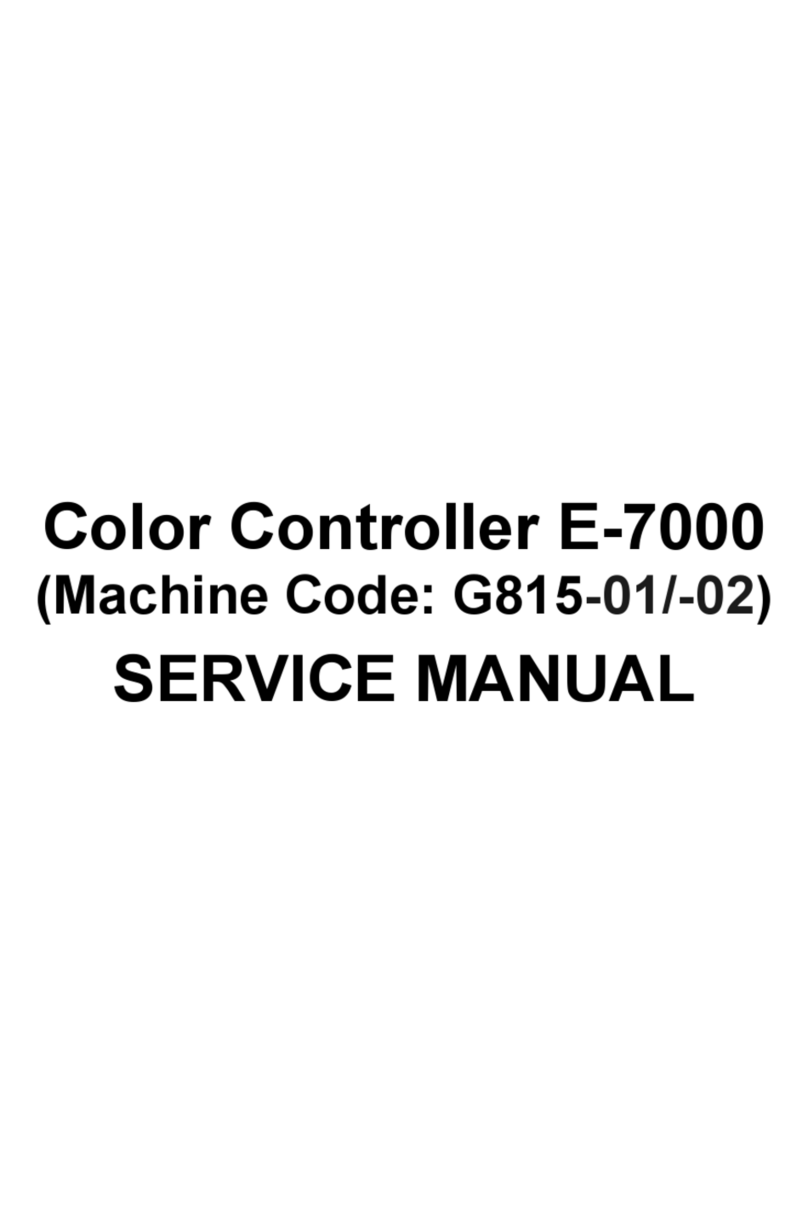
Ricoh
Ricoh E-7000 Service manual
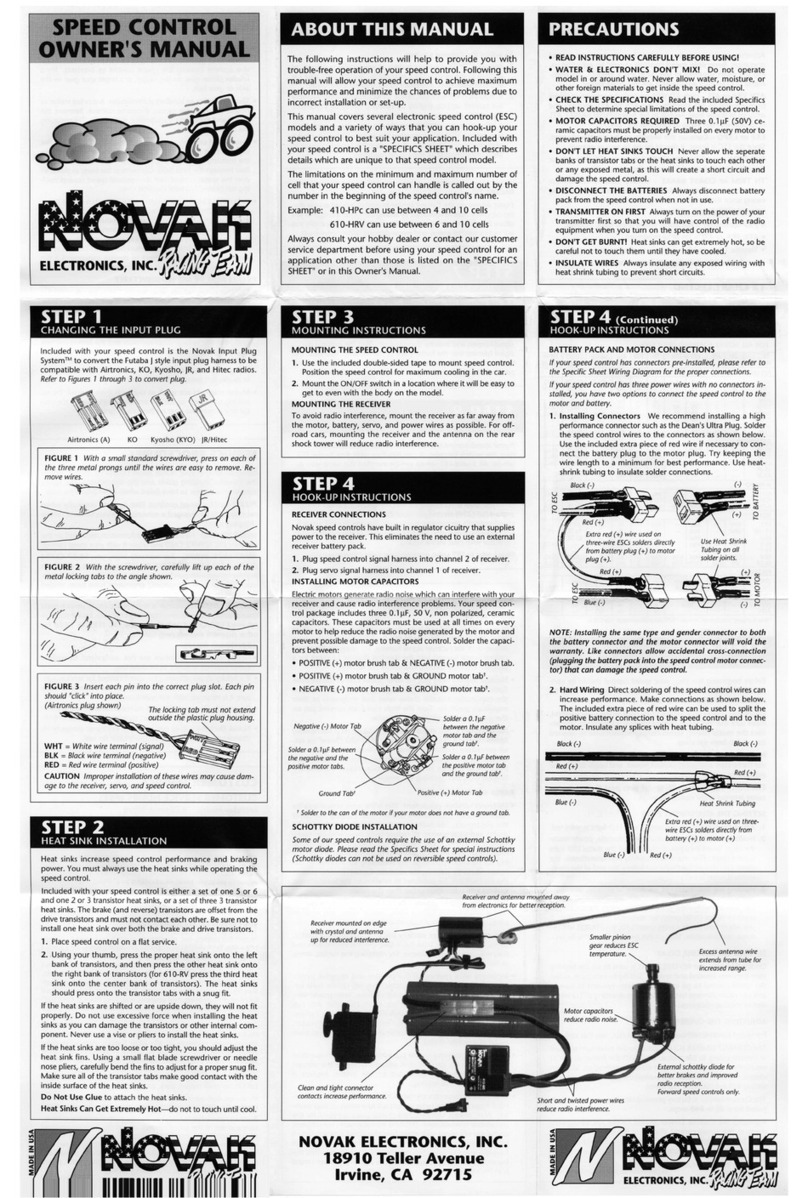
NOVAK
NOVAK 610-RV owner's manual
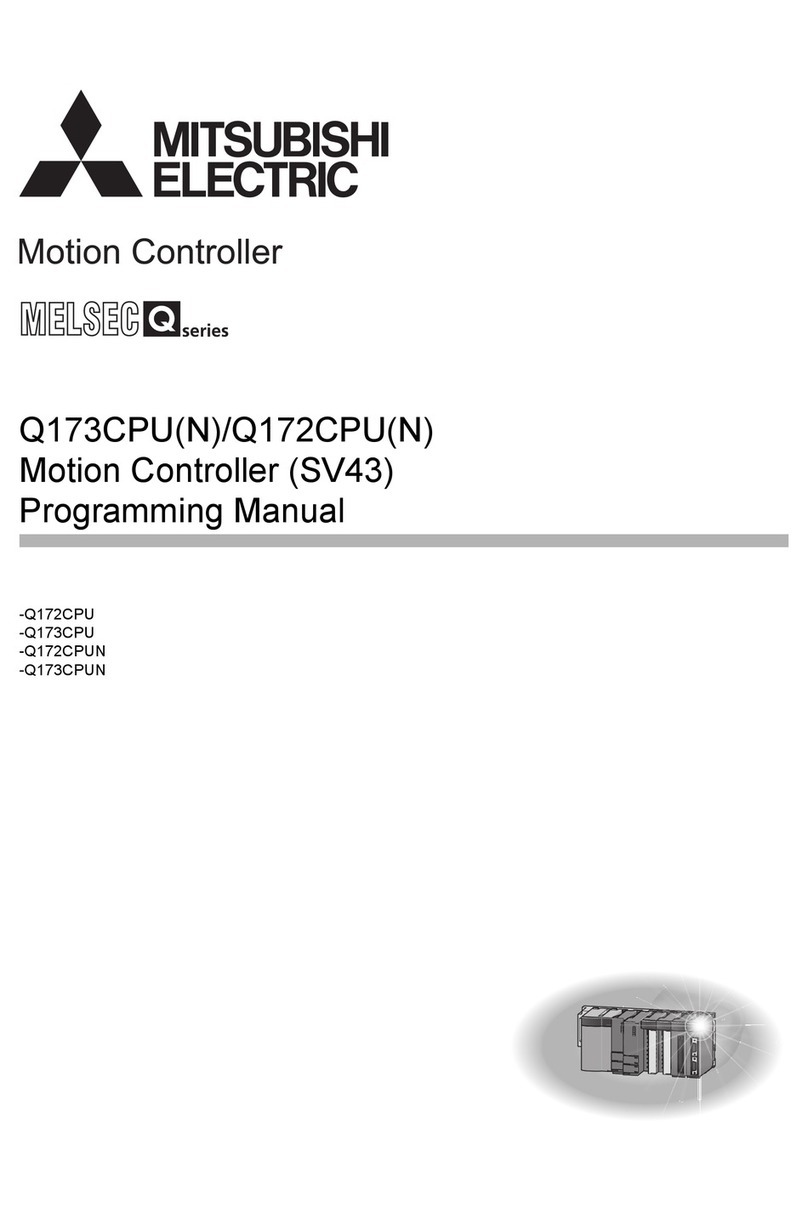
Mitsubishi Electric
Mitsubishi Electric Q172CPU Programming manual
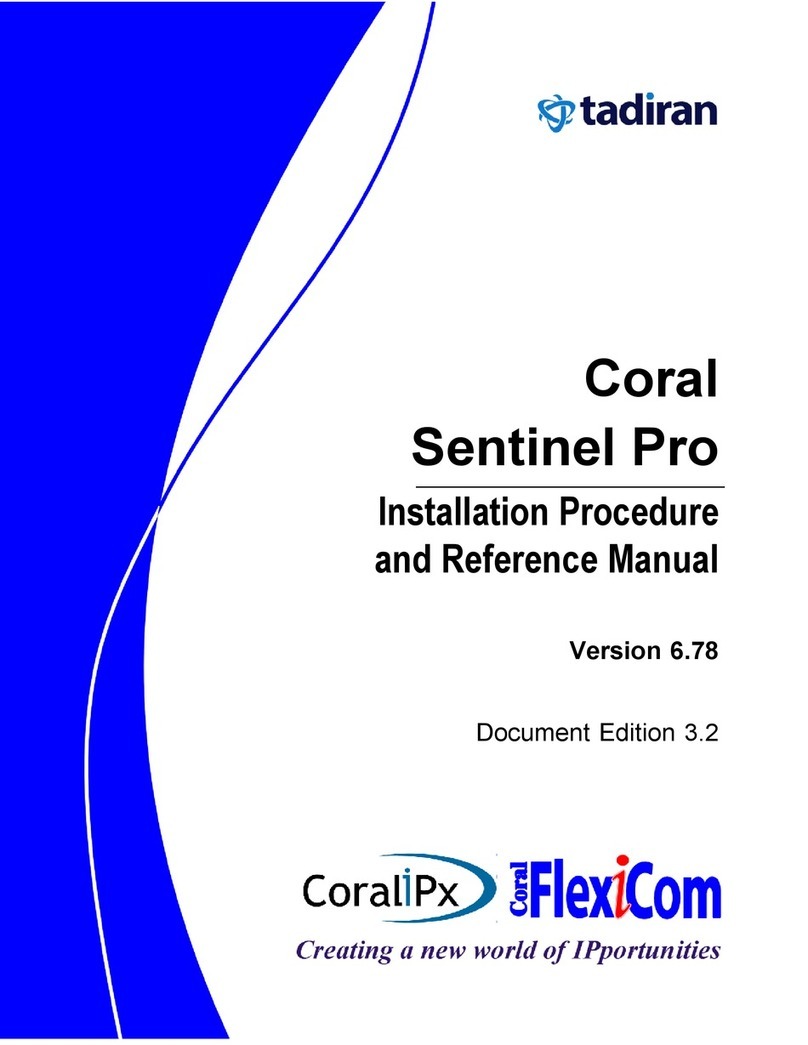
Tadiran Telecom
Tadiran Telecom Coral Sentinel Pro Installation Procedure and Reference Manual
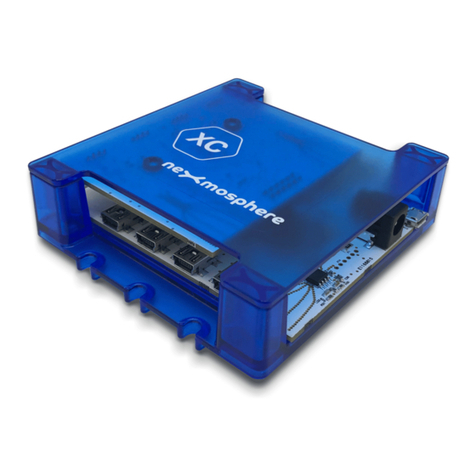
Nexmosphere
Nexmosphere XC-931 quick start guide
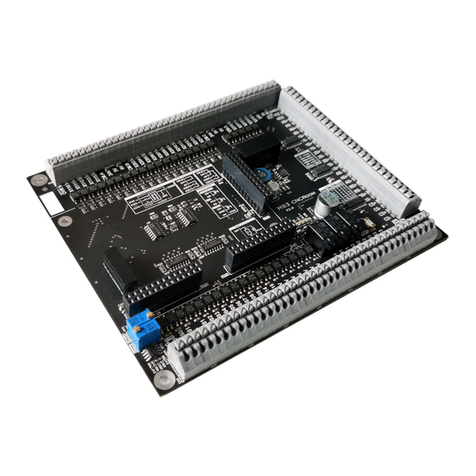
CNCroom
CNCroom MB3 owner's manual
